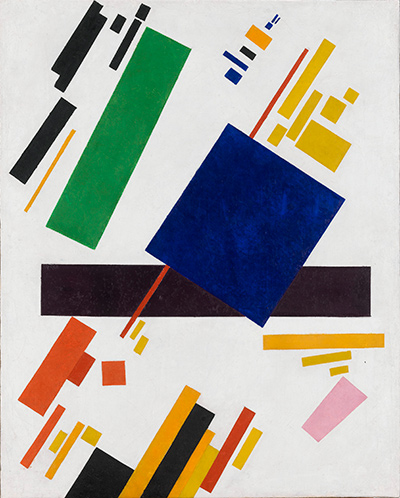Kazimir Malevich was a Soviet artist who did the best part of his work during the last decades of the 19th century and the first decades of the 20th century.
His speciality was abstract geometric art and he was well known for such pieces, even though they were later banned by the Soviet Union because they were considered bourgeois works.
One of Malevich's major contributions to art was the founding of the Suprematism movement. The defining attributes of Suprematism are straightforward geometrical shapes and limited number of colours. The term itself refers to the 'supremacy' of artistic feeling rather than an actual representation of real-life objects or scenery.
Suprematist Composition is one of the best examples of this art movement. It is an icon of Russian art, even though it had been banned for years by the Soviet government. The painting depicts a number of rectangles in bright colours. The colours most represented in the painting are blue, black, green, yellow, orange, red, and pink.
Despite the limitation of the colour palette, the painting appears to be bright and visual. Another name for the painting is also Blue Rectangle Over Red Beam, a very accurate description of the painting in real terms.
The painting has been hard to interpret for many artists because of its pure abstractness, and hence Malevich wrote a 4000 word essay describing the painting's goals, meaning, and overall philosophy. Art historians have since used this essay to colour their own interpretation of this work. Some interesting nuggets of information can also be obtained from his book, From Cubism and Futurism to Suprematism: The New Realism in Painting.
Suprematist Composition: Blue Rectangle Over Red Beam represents a complete break from the past for Malevich. It clearly shows that the artist wanted to create something new for a new world emerging during the time. The idea for this piece of art comes from an anarchic architecture of shapes, and represents the depiction of geometry and colour within a small space.
Malevich painted Suprematist Composition: Blue Rectangle Over Red Beam in 1916 and it was one of his favourite works. He exhibited the painting in Moscow at the 1919 - 1920 State Exhibition, and it sealed his reputation as a great artist. The painting became intensely popular and so did Malevich. The artist kept the painting with him until June 1927 and did not want to sell it.
Malevich finally gave the painting to a close friend called Hugo Häring, a renowned German architect. He still had the painting when Malevich died and kept it safe during the war years from the Nazis who were on an art destroying spree. He finally sold it to the Stedelijk Museum in Amsterdam, Netherlands, in 1958. The painting remained in the museum's possession for the next five decades.
It was finally returned to the heirs of Malevich, who fought for it in the courts for close to seventeen years. The painting was sold recently in 2008 at Sotheby's in London. Suprematist Composition: Blue Rectangle Over Red Beam went for the colossal amount of $60 million.
It is considered to be the highest priced art piece from Russia and is one of the most expensive artworks of all time. The buyer, however, remains anonymous, and viewers can no longer see this painting. However, the meaning behind this artwork can be debated for a long time to come.




